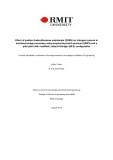
Wastewater Organics
-
The primary objectives of this study were to: Investigate the fouling potential, and characterise the organic components of the membrane foulant layers, of clarified activated sludge and lagoon effluent obtained from the WTP; Investigate the fouling propensities of EOM and AOM derived from a blue-green algal culture as it passed through the growth cycle, ie., for which the cells had not been subject to physical disruption; Determine any difference in the fouling propensity of EOM and AOM and relate it to organic composition.
 99p
99p  runthenight07
runthenight07
 01-03-2023
01-03-2023
 3
3
 3
3
 Download
Download
-
Municipal wastewater treatment plants generally utilise biological activated sludge processes to remove organic compounds and nitrogen. The biological nitrogen removal (BNR) occurs in two steps, nitrification (ammonium removal) and denitrification (nitrates removal). This study focused on a medium-sized wastewater treatment plant (WTP) which experienced poor nitrification for years, mainly when the weather temperature drops.
 125p
125p  runthenight07
runthenight07
 01-03-2023
01-03-2023
 11
11
 3
3
 Download
Download
-
The objective of this project was to develop \(Ti{O_2}\) based multifunctional substrates through silver decoration, while simultaneously enhancing the photocatalytic performance of \(Ti{O_2}\) in the substrate. Employing Ag nanoparticles introduced additional functionality to the system, namely surface-enhanced Raman scattering (SERS), thus enabling the detection of trace amounts of organic molecules prior to their degradation, all with the same substrate.
 123p
123p  runthenight04
runthenight04
 02-02-2023
02-02-2023
 10
10
 2
2
 Download
Download
-
The aim of this study is to enhance biogas production from the organic fraction of municipal solid waste (OFMSW) and garden waste (GW) via pretreatment and codigestion. In order to achieve the aims of the study, two objectives have been developed and are outlined below: To investigate an optimum co-digestion mixture of OFMSW with untreated and pretreated GW; to investigate the effectiveness of different pretreatments on the potential for biogas production from GW and to identify the relationship between certain changes in GW characteristics and enhanced yield.
 150p
150p  runthenight04
runthenight04
 02-02-2023
02-02-2023
 8
8
 2
2
 Download
Download
-
This article discusses testing results of industrial trial of new wastewater disinfection comprised of combined use of ultrasonic and ultraviolet methods at final stage of wastewater treatment aimed at elimination of pathogenic organisms, thereby preventing spread of infectious diseases.
 8p
8p  lucastanguyen
lucastanguyen
 01-06-2020
01-06-2020
 18
18
 2
2
 Download
Download
-
Research Reports IWMI’s mission is to improve the management of land and water resources for food, livelihoods and environment. In serving this mission, IWMI concentrates on the integration of policies, technologies and management systems to achieve workable solutions to real problems—practical, relevant results in the field of irrigation and water and land resources.
 39p
39p  nhatro75
nhatro75
 12-07-2012
12-07-2012
 72
72
 8
8
 Download
Download
CHỦ ĐỀ BẠN MUỐN TÌM



















